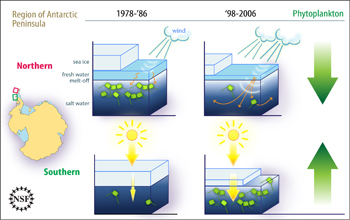All Images
News Release 09-042
Climate-related Changes on the Antarctic Peninsula Being Driven from the Top and the Bottom of the Ecosystem
This material is available primarily for archival purposes. Telephone numbers or other contact information may be out of date; please see current contact information at media contacts.

Rapid climate change on the Antarctic Peninsula is known to have affected many facets of the food chain--but a recent study has shown even its very base, the phytoplankton, have responded in two quite contrasting ways based on geographical location.
In the north of the peninsula seasonal sea ice has diminished and retreated. The fresh water melt-off that used to shield the water column from winds is much smaller now. Stronger winds mix the water forcing phytoplankton down to depths where they can no longer photosynthesize or reproduce. The phytoplankton population in the north has vastly diminished.
In the south of the peninsula--the year-round sea ice cover has retreated and diminished. In areas where sunlight could not penetrate enough to sustain a large phytoplankton population--it is now more readily available and phytoplankton populations have gone up.
Credit: Zina Deretsky / NSF
Download the high-resolution JPG version of the image. (557 KB)
Use your mouse to right-click (Mac users may need to Ctrl-click) the link above and choose the option that will save the file or target to your computer.

The researchers' findings were published in the March 13, 2009, issue of Science magazine.
Credit: Copyright 2009 AAAS
Download the high-resolution JPG version of the image. (742 KB)
Use your mouse to right-click (Mac users may need to Ctrl-click) the link above and choose the option that will save the file or target to your computer.


